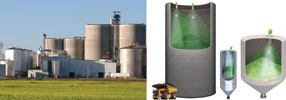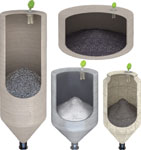

The monitoring of bulk solids in storage silos for companies that mine, handle or manufacture granular products, forms a pivotal link in supply chain efficiency and directly affects production output and profits – knowing the safety stock levels accurately equals more money in the bank.
Although inventory, production and financial managers may all agree with the above statement, it does not mean that all parties have the same priorities. There are certain reoccurring challenges when it comes to silo monitoring that cause conflict between managers, the most common being: “What safety stock levels should we hold?” This dilemma arises simply because current technologies and methods being employed for silo stock monitoring were never specifically designed for the application and resulted in unreliable stock level reporting. This left managers with the task of predicting delivery and production schedules without accurate information.
Traditional methods such as ultrasonic, radar and laser level transmitters only measure a single sample point across the entire uneven surface of the stored material. Therefore readings will differ drastically depending on where the instrument is installed on top of the silo. This is true for ‘dip testing’ as well. Also, these traditional methods cannot always penetrate the dust cloud and many cannot measure during filling or emptying. This leads to unreliable stock level reports being sent to management, causing a tendency to hold higher levels of safety stock material to avoid shortages that would halt production. Ultimately this leads to higher than necessary production costs and reduced profitability due to the cost of the excess stock.
Two important questions to move towards more profitable safety stock levels for accurate and predictable inventory control:
1. What are the essential requirements for useful silo monitoring?
2. What are the common physical challenges that current methods cannot overcome?
Although each application is different, there are generally four requirements that are most important:
* High level of accuracy.
* Continuous measurement capability.
* Open communication system.
* Calculated mass, volume and level measures.

To answer the second question, consider the four most common obstacles faced when measuring stored bulk solids:
1. Suspended dust – in a typical silo there is an inherent amount of dust present in the space between the stock level and the top of the silo. The finer the stored granules, the denser the dust cloud. This can become quite severe during filling and emptying of the silo and can take hours to settle. Advanced laser technology is now widely available and able to accurately scan large uneven surfaces, however lasers cannot penetrate dust effectively and readings often require human manipulation or ‘cleaning up’. Traditional ultrasonic level transmitters installed at the top of silos use a sound frequency which cannot penetrate the dust cloud sufficiently to measure the stock level accurately, in some cases not at all. Ideally an instrument that operates in the range 3-10 kHz is required. The 3D LevelScanner IIfrom Israeli based APM has electronic transducers that operate dynamically within this optimal frequency range. The instrument adjusts automatically within this range to suite the particular application and installation, ensuring penetration to the stored solid’s actual surface profile.
2. Various silo shapes – businesses often utilise unique silo shapes in order to meet their particular process requirements, sometimes there are even multiple silo shapes and sizes per site. Also silos that are the same in geometry may store products of different mass properties, different dust cloud density etc. These differences create the necessity for plant managers to utilise various measuring techniques on the same plant to acquire accurate level, volume and mass readings. This reduces the reliability of measurements, increases labour costs, increases instrumentation costs and increases potential points of failure in the production process. The maintenance of this type of silo monitoring system is very difficult and expensive to manage. The 3D LevelScanner II has on-board silo/bunker manipulation firmware as well as versatile management software, allowing users to ‘teach’ each unit the specific application properties of each different silo under monitoring. This would include specific silo geometry, specific material density for mass measurement and mapping of small obstructions etc. One instrument for practically every silo shape and all bulk materials using a universal Windows based system for accurate inventory control.
3. Uneven measuring surface – an under-estimated challenge is the nature of stored bulk solids to pile randomly creating an extremely uneven measuring surfaces. Vastly different from measuring the level of a stored liquid which is flat. Since traditional measuring methods only measure a single point across the entire uneven surface, the readings can often be unreliable. Dip testing, single horn radar/ultrasonic and capacitance probes all only read the level at one single sample point. So depending on where the instrument is mounted, that will determine the level that is transmitted to the control centre. Because of the random accumulation of product inside the silo, the level on the right side could be vastly different from that on the left side and again different in the middle. The larger the silo the larger this difference will be and the more inaccurate the volume, mass and level readings will be. In order accurately to measure an uneven surface an instrument that can read many different points across the profile is required. The APM system has 3 integral transmitting horns and each transmit wide pulses (up to 70 degrees wide) to cover a larger surface area. The multi horn technology enables the instrument to measure approximately every 20 square centimetres of the entire surface profile. It then combines the results to give the profile of the uneven surface with an accuracy of 1-3%. The instrument then transmits an accurate volume, mass, maximum, minimum land average level, as well as a 3D image of the profile. Having the 3D graphic has the added benefit of assisting managers to curb any bridging in the silo, which improves silo maintenance scheduling.
4. Closed communication system – the 3D level scanner requires no additional outside calculations after initial installation setup, all calculations are done on-board. The RS485 communications and Modbus registers allow for easy transmission and acquisition of the readings by an existing client network. Furthermore, converting the RS485 to Ethernet allows the user to transmit and communicate via TCP/IP over 10/100 networks or even Wi-Fi.
Having continuous accurate silo stock readings allows the management team to reduce safety stock levels, plan and predict production, forecast costs and accurately measure material usage in recipes. The trick is achieving the required level of accuracy (1-3%) by measuring and combining multiple points across the surface profile. The equipment must be able to calculate the mass/volume/level readings without human interference and continuously transmit the readings using a universal communication protocol.
| Tel: | +27 11 795 9500 |
| Email: | [email protected] |
| www: | www.allpronix.com |
| Articles: | More information and articles about Allpronix |
© Technews Publishing (Pty) Ltd | All Rights Reserved